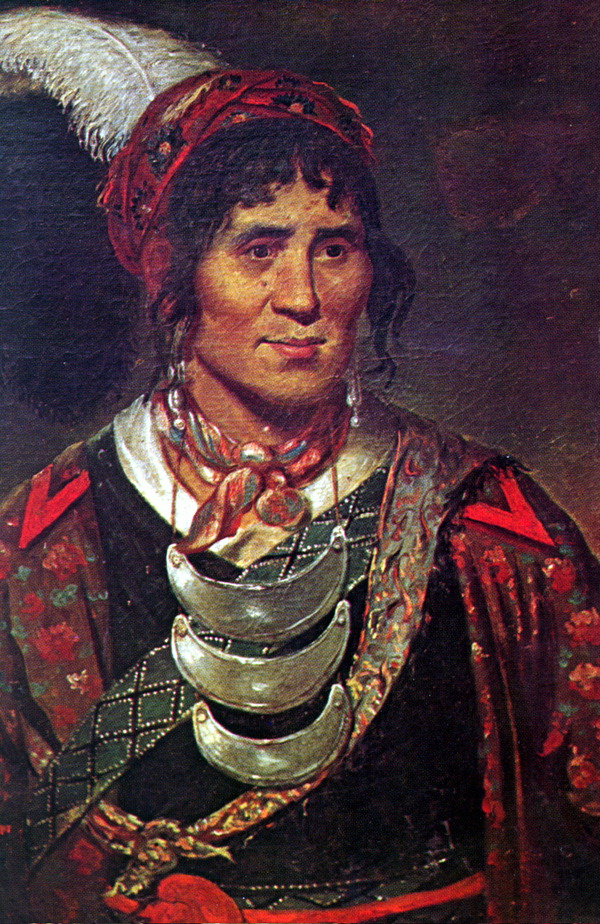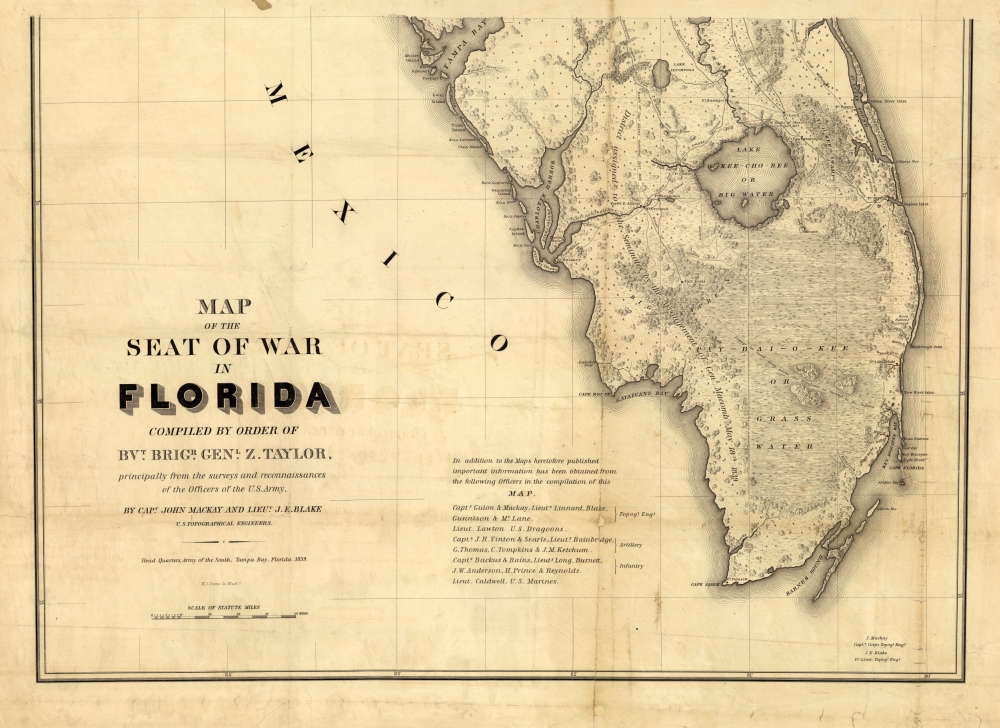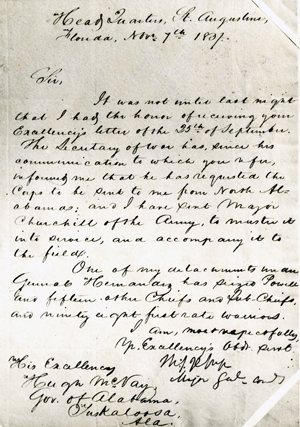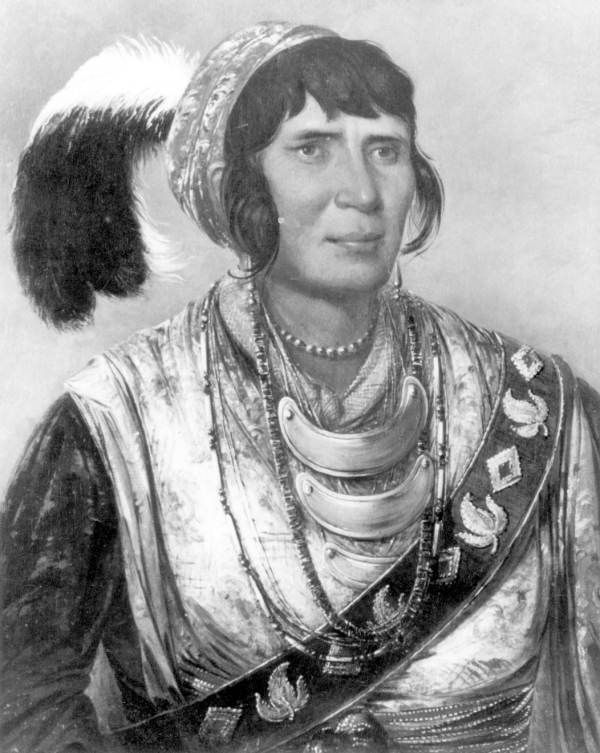Description of previous item
Description of next item
Osceola (ca. 1804-1838)
Published January 1, 2013 by Florida Memory
On January 30, 1838, the famed Seminole warrior Osceola died at Fort Moultrie in Charleston, South Carolina.
Osceola is an Anglicized version of Asi-Yaholo, meaning "black drink speaker" in the Muscogee language. Asi-Yaholo is not actually a name, but a title. In this case it refers to a function performed at the Green Corn Dance. The black drink was a caffeinated beverage made from the leaves of yaupon holly (Ilex vomitoria) consumed as part of the ritual process associated with the Green Corn Dance. Osceola may also have been known as Tallassee Tustenuggee, a war title attached to his home village. Therefore, we do not know his personal name; we only know titles he earned in connection with the black drink, the Green Corn Dance and the military-political structure of the Muscogee-Creeks.
Another layer of confusion surrounding Osceola's name and identity is that he was often known as Billy Powell to Anglo-Americans. William Powell was an Indian trader sometimes identified as the father of Osceola, though it appears more likely that Powell married Osceola's mother after his birth.
Osceola was probably born in Tallassee, a Creek Indian town in eastern Alabama, circa 1804. He came to Florida with his family during the Red Stick War (1813-1814). Osceola rose to prominence among the Florida Seminoles during the tense period leading up to the outbreak of the Second Seminole War (1835-1842). He emerged as one of the most vocal opponents of Indian removal among the Seminoles in Florida.
On December 28, 1835, Osceola led an attack on Fort King (near modern-day Ocala) which resulted in the assassination of the American Indian Agent Wiley Thompson. Simultaneously, Micanopy and a large band of Seminole warriors ambushed troops under the command of Major Francis Dade south of Fort King on the road to Fort Brooke (later Tampa). These two events, along with the Battle of Withlacoochee on December 31 and raids on sugar plantations in East Florida in early 1836, marked the beginning of the Second Seminole War.
Excerpt from "A Map of the Seat of War in Florida" by Captain John Mackay and Lieutenant J. Black, U.S. Topographical Engineers, 1840
In the below letter to Governor Hugh McVay of Alabama, a copy of which resides in the State Library of Florida's Manuscript Collection, General Thomas Sidney Jesup reported: "One of my detachments under General Hernandez has seized Powell and fifteen other Chiefs and Sub-Chiefs, and ninety eight first rate warriors."
Jesup failed to mention the tactics used to apprehend Osceola. In late October 1837, Osceola contacted General Joseph Hernandez, through a black interpreter named John Cavallo (also John Horse), to arrange negotiations about ceasing hostilities. Jesup responded by ordering Hernandez to seize Osceola and his party should he have the chance.
Osceola's camp, located one mile south of Fort Peyton, raised a white flag of truce in order to signal their desire to negotiate. When Hernandez and his entourage reached the camp, they promptly seized Osceola and the warriors, women and children present. Osceola and his band were brought to St. Augustine and imprisoned at Fort Marion (Castillo de San Marcos).
Remarkably, on November 30, Coacoochee (Wildcat) and 19 other Seminoles escaped Fort Marion; Osceola was not among them. Coacoochee's escape prompted Jesup to transfer the most important Seminole captives out of the area. In late December 1837, Osceola, Micanopy, Philip and about 200 Seminoles embarked from St. Augustine for Fort Moultrie in Charleston.
Osceola, who previously contracted malaria in Florida, became severely ill soon after arriving at Fort Moultrie. During his brief incarceration in South Carolina, Osceola sat for a portrait by George Catlin just days before his death on January 30.
Osceola was buried on the grounds of Fort Moultrie. The epitaph on his tombstone reads: "Oceola/ Patriot and Warrior/ Died at Fort Moultrie/ January 30, 1838."
Cite This Article
Chicago Manual of Style
(17th Edition)Florida Memory. "Osceola (ca. 1804-1838)." Floridiana, 2013. https://www.floridamemory.com/items/show/257494.
MLA
(9th Edition)Florida Memory. "Osceola (ca. 1804-1838)." Floridiana, 2013, https://www.floridamemory.com/items/show/257494. Accessed March 23, 2025.
APA
(7th Edition)Florida Memory. (2013, January 1). Osceola (ca. 1804-1838). Floridiana. Retrieved from https://www.floridamemory.com/items/show/257494

 Listen: The Gospel Program
Listen: The Gospel Program


